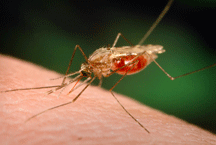
As floodwaters recede in many areas of the Midwest, its residents most likely are breathing a sigh of relief. However, those same waters may have left behind residual problems in the form of an increase in mosquito-borne diseases and illnesses, according to Catherine Young, a biologist with the University of Notre Dames Eck Family Institute for Global Health and Infectious Diseases.
Young notes that the recent floods are quite likely to raise mosquito populations.
In the short term, we will probably see a spike in so-called floodwaterspecies, which in most affected areas at this time of the year are primarily Aedes vexans and Aedes trivittatus,she said.Both of them are black-and-white mosquitoes which bite mostly during the day and are extremely irritating. The good news is that both of them are very poor carriers of the West Nile virus and are more of a nuisance than a health risk to humans. However, they do transmit heartworm, so people should be careful to protect their pets from mosquito bites or get them onto anti-heartworm medication.
However, the stagnant waters left behind by the floods could possibly serve as ideal breeding grounds for much more effective and potent disease-carrying mosquitoes. Unfortunately, again, much depends on the weather.
As the floodwaters recede, they will probably leave behind a lot of small puddles and pools of dirty water that will stagnate as the weather becomes hotter and drier,Young said.This is dangerous because dirty, stagnant water is the perfect breeding ground for Culex mosquitoes, the small brown species that are the primary vectors of West Nile and St. Louis encephalitis viruses.
These mosquitoes bite mostly around dusk and are dawn andmuch less of a nuisance that the Aedes, since they tend to attack less frequently and in smaller numbers, so people may be tempted to skip the bug spray as the Culex take over from the Aedes. However, as the overall number of bites goes down, the risk of infection per bite can go up, because the Culex are much better virus carriers than the Aedes.
The National Weather Service has predicted temperatures at or below normal though July in most areas of the Midwest, which might be just the break residents of flood-ravaged areas need.
Hot weather also creates a more favorable environment for the virus itself,Young said.West Nile transmission usually peaks in August and September, and the hotter the summer, the more active the virus tends to be.
Regardless of the type of mosquito or the type of weather, prevention is still the best cure, according to Young.
The precautions are standard: eliminate mosquito breeding grounds by removing standing water around the house,she said.Standing water that people want to keep, such as birdbaths and kiddie pools, should have the water changed at least once or twice a week to prevent mosquito larvae from developing. Rainwater collecting barrels should be covered with tight-fitting screens to prevent mosquitoes from laying eggs inside. Ponds can be treated with a mosquito-specific insecticide, such as Bacillus thuringensis israelensis (BTI).
People spending time outdoors should wear insect repellant and/or long-sleeved, light-colored clothing, especially around dawn and dusk.
_ Contact: Catherine Young, Eck Family Institute for Global Health and Infectious Diseases, 574-234-4060, or_ " cyoung@nd.edu ":mailto:cyoung@nd.edu
TopicID: 28547